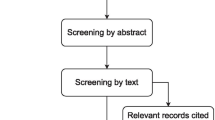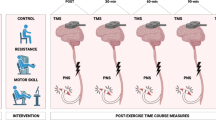Abstract
Although important differences exist between learning a new motor skill and adapting a well-learned skill to new environmental constraints, studies of force field adaptation have been used frequently in recent years to identify processes underlying learning. Most of these studies have been of reaching tasks that were each hand position was specified by a unique combination of joint angles. At the same time, evidence has been provided from a variety of tasks that the central nervous system takes advantage of the redundancy available to it when planning and executing functional movements. The current study attempted to determine whether a change in the use of joint motion redundancy is associated with the adaptation process. Both experimental and control subjects performed 160 trials of reaching in each of four adaptation phases, while holding the handle of a robot manipulandum. During the first and last adaptation phases, the robot motors were turned off. During phases 2 and 3 the motors produced a velocity-dependent force field to which experimental subjects had to adapt to regain relatively straight line hand movements during reaching to a target, while the motors remained off for the control group. The uncontrolled manifold (UCM) method was used to partition the variance of planar clavicle–scapular, shoulder, elbow and wrist joint movements into two orthogonal components, one (V UCM) that reflected combinations of joint angles that were equivalent with respect to achieving the average hand path and another (V ORT) that took the hand away from its average path. There was no change in either variance component for the control group performing 640 non-perturbed reaches across four ‘pseudo-adaptation’ phases. The experimental group showed adaptation to reaching in the force field that was accompanied initially by an increase in both components of variance, followed by a smaller decrease of V UCM than V ORT during 320 practice reaches in the force field. After initial re-adaptation to reaching to the null field, V UCM was higher in experimental than in control subjects after performing a comparable number of reaches. V UCM was also larger in the experimental group after re-adaptation when compared to the 160 null field reaching trials performed prior to initial force field introduction. The results suggest that the central nervous system makes use of kinematic redundancy, or flexibility of motor patterns, to adapt reaching performance to unusual force fields, a fact that has implications for the hypothesis that motor adaptation requires learning of formal models of limb and environmental dynamics.






Similar content being viewed by others
References
Bagesteiro LB, Sainburg RL (2005) Interlimb transfer of load compensation during rapid elbow joint movements. Exp Brain Res 161:155–165
Bagesteiro LB, Sainburg RL (2003) Nondominant arm advantages in load compensation during rapid elbow joint movements. J Neurophysiol 90:1503–1513
Bernstein N (1967) The coordination and regulation of movements. Pergamon Press, New York
Brashers-Krug T, Shadmehr R, Todorov E (1995) Catastrophic interference in human motor learning. Adv Neural Inf Process Syst 7:19–26
Buch ER, Young S, Contreras-Vidal JL (2003) Visuomotor adaptation in normal aging. Learn Memory 10:55–63
Burdet E, Osu R, Franklin DW, Milner TE, Kawato M (2001) The central nervous system stabilizes unstable dynamics by learning optimal impedance. Nature 414:446–449
Caillou N, Delignieres D, Nourrit D, Deschamps T, Lauriot B (2002) Overcoming spontaneous patterns of coordination during the acquisition of a complex balancing task. Can J Exp Psychol 56:283–293
Davidson PR, Wolpert DM (2005) Widespread access to predictive models in the motor system: a short review. J Neural Eng 2:S313–S319
Dizio P, Lackner JR (1995) Motor adaptation to coriolis force perturbations of reaching movements: endpoint but not trajectory adaptation transfers to the nonexposed arm. J Neurophysiol 74:1787–1792
Domkin D, Laczko J, Djupsjobacka M, Jaric S, Latash ML (2005) Joint angle variability in 3D bimanual pointing: uncontrolled manifold analysis. Exp Brain Res 163:44–57
Domkin D, Laczko J, Jaric S, Johansson H, Latash ML (2002) Structure of joint variability in bimanual pointing tasks. Exp Brain Res 143:11–23
Feldman AG (1986) Once more on the equilibrium-point hypothesis (lambda model) for motor control. J Mot Behav 18:17–54
Feldman AG, Adamovich SV, Levin MF (1995) The relationship between control, kinematic and electromyographic variables in fast single-joint movements in humans. Exp Brain Res 103:440–450
Feldman AG, Levin MF, Mitnitski AM, Archambault P (1998) 1998 ISEK Congress Keynote Lecture: Multi-muscle control in human movements. International Society of Electrophysiology and Kinesiology. J Electromyogr Kinesiol 8:383–390
Gandolfo F, Mussa-Ivaldi FA, Bizzi E (1996) Motor learning by field approximation. Proc Natl Acad Sci USA 93:3843–3846
Gelfand IM, Latash ML (1998) On the problem of adequate language in motor control. Mot Control 2:306–313
Gelfand IM, Tsetlin ML (1966) On mathematical modeling of the mechanisms of the central nervous system. In: Gelfand IM, Gurfinkel VS, Fogt N, Tsetlin ML (eds) Models of the structural–functional organization of certain biological systems. Nauka, Moscow, pp 9–26
Guenther FH, Barreca DM (1997) Neural models for flexible control of redundant systems. In: Morasso PG, Sanguenetti V (eds). Self-organization, computational maps and motor control. Elsevier/North Holland, St. Louis, pp 383–421
Hwang EJ, Shadmehr R (2005) Internal models of limb dynamics and the encoding of limb state. J Neural Eng 2:S266–S278
Kang N, Shinohara M, Zatsiorsky VM, Latash ML (2004) Learning multi-finger synergies: an uncontrolled manifold analysis. Exp Brain Res 157:336–350
Ko YG, Challis JH, Newell KM (2003) Learning to coordinate redundant degrees of freedom in a dynamic balance task. Hum Mov Sci 22:47–66
Krishnamoorthy V, Latash ML, Scholz JP, Zatsiorsky VM (2003) Muscle synergies during shifts of the center of pressure by standing persons. Exp Brain Res 152:281–292
Krishnamoorthy V, Latash ML, Scholz JP, Zatsiorsky VM (2004) Muscle modes during shifts of the center of pressure by standing persons: effect of instability and additional support. Exp Brain Res 157:18–31
Krishnamoorthy V, Yang JF, Scholz JP (2005) Joint coordination during quiet stance: effects of vision. Exp Brain Res 164:1–17
Latash ML, Scholz JP, Danion F, Schöner G (2002a) Finger coordination during discrete and oscillatory force production tasks. Exp Brain Res 146:419–432
Latash ML, Scholz JP, Schöner G (2002b) Motor control strategies revealed in the structure of motor variability. Exerc Sport Sci Rev 30:26–31
Latash ML, Kang N, Patterson D (2002c) Finger coordination in persons with Down syndrome: atypical patterns of coordination and the effects of practice. Exp Brain Res 146:345–355
Latash ML, Scholz JP, Danion F, Schöner G (2001) Structure of motor variability in marginally redundant multifinger force production tasks. Exp Brain Res 141:153–165
Latash ML, Yarrow K, Rothwell JC (2003) Changes in finger coordination and responses to single pulse TMS of motor cortex during practice of a multifinger force production task. Exp Brain Res 151:60–71
Latash ML, Shim JK, Smilga AV, Zatsiorsky V (2005) A central back-coupling hypothesis on the organization of motor synergies: a physical metaphor and a neural model. Biol Cybern 92:186–91
Malfait N, Shiller DM, Ostry DJ (2002) Transfer of motor learning across arm configurations. J Neurosci 22:9656–9660
Malfait N, Gribble PL, Ostry DJ (2005) Generalization of motor learning based on multiple field exposures and local adaptation. J Neurophysiol 93:3327–3338
Martin V, Scholz JP, Schöner G (2004) Theory of the uncontrolled manifold: variance, self-motion, and neuronal noise. Program No. 871.17. 2004 Abstract Viewer and Itinerary Planner. Society for Neuroscience, Washington, DC. Online. 34th Annual Meeting of the Society for Neuroscience, San Diego, October 23–27
Martin V, Scholz JP, Schöner G (2005) A theoretical account for the uncontrolled manifold and motor equivalence in pointing movements. Progress in Motor Control V, Pennsylvania State University. University Park, August 17–20
McDonald PV, Van Emmerik RE, Newell KM (1989) The effects of practice on limb kinematics in a throwing task. J Mot Behav 21:245–264
Oldfield RC (1971) The assessment and analysis of handedness: the Edinburgh inventory. Neuropsychologia 9:97–113
Reisman DS, Scholz JP, Schöner G (2002) Differential joint coordination in the tasks of standing up and sitting down. J Electromyogr Kinesiol 12:493–505
Scheidt RA, Reinkensmeyer DJ, Conditt MA, Rymer WZ, Mussa-Ivaldi FA (2000) Persistence of motor adaptation during constrained, multi-joint, arm movements. J Neurophysiol 84:853–862
Scholz JP, Schöner G (1999) The uncontrolled manifold concept: identifying control variables for a functional task. Exp Brain Res 126:289–306
Scholz JP, Schöner G, Latash ML (2000) Identifying the control structure of multijoint coordination during pistol shooting. Exp Brain Res 135:382–404
Scholz JP, Reisman D, Schöner G (2001) Effects of varying task constraints on solutions to joint coordination in a sit-to-stand task. Exp Brain Res 141:485–500
Scholz JP, Danion F, Latash ML, Schöner G (2002) Understanding finger coordination through analysis of the structure of force variability. Biol Cybern 86:29–39
Scholz JP, Kang N, Patterson D, Latash ML (2003) Uncontrolled manifold analysis of single trials during multi-finger force production by persons with and without Down syndrome. Exp Brain Res 153:45–58
Schöner G (1995) Recent development and problems in human movement science and their conceptual implications. Ecol Psychol 7:291–314
Shadmehr R, Brashers-Krug T (1997) Functional stages in the formation of human long-term motor memory. J Neurosci 17:409–419
Shadmehr R, Mussa-Ivaldi FA (1994) Adaptive representation of dynamics during learning of a motor task. J Neurosci 14:3208–3224
Shadmehr R, Moussavi ZM (2000) Spatial generalization from learning dynamics of reaching movements. J Neurosci 20:7807–7815
Shadmehr R, Mussa-Ivaldi FA, Bizzi E (1993) Postural force fields of the human arm and their role in generating multijoint movements. J Neurosci 13:45–62
Shadmehr R, Brashers-Krug T, Mussa-Ivaldi FA (1995) Interference in learning internal models of inverse dynamics in humans. Adv Neural Inf Process Syst 7:1117–1124
Shinohara M, Scholz JP, Zatsiorsky VM, Latash ML (2004) Finger interaction during accurate multi-finger force production tasks in young and elderly persons. Exp Brain Res 156:282–292
Smith DR, McCabe DR, Wilkerson JD (2001) An analysis of a discrete complex skill using Bernstein’s stages of learning. Percept Mot Skills 93:181–191
Takahashi CD, Scheidt RA, Reinkensmeyer DJ (2001) Impedance control and internal model formation when reaching in a randomly varying dynamical environment. J Neurophysiol 86:1047–1051
Thoroughman KA, Shadmehr R (1999) Electromyographic correlates of learning an internal model of reaching movements. J Neurosci 19:8573–8588
Todorov E (2004) Optimality principles in sensorimotor control. Nat Neurosci 7:907–915
Tseng YW, Scholz JP (2005a) The effect of workspace on the use of motor abundance. Mot Control 9:75–100
Tseng YW, Scholz JP (2005b) Unilateral vs. bilateral coordination of circle-drawing tasks. Acta Psychol (Amst) 120:172–198
Tseng Y, Scholz JP, Schöner G (2002) Goal-equivalent joint coordination in pointing: effect of vision and arm dominance. Mot Control 6:183–207
Tseng YW, Scholz JP, Schöner G, Hotchkiss L (2003) Effect of accuracy constraint on joint coordination during pointing movements. Exp Brain Res 149:276–288
Vereijken B, van Emmerik REA, Whiting HTA, Newell KM (1992) Free(z)ing degrees of freedom in skill acquisition. J Mot Behav 24:133–142
Wang J, Sainburg RL (2004a) Interlimb transfer of novel inertial dynamics is asymmetrical. J Neurophysiol 92:349–360
Wang J, Sainburg RL (2004b) Limitations in interlimb transfer of visuomotor rotations. Exp Brain Res 155:1–8
Yang JF, Scholz JP (2005) Learning a throwing task is associated with differential changes in the use of motor abundance. Exp Brain Res 163:137–158
Acknowledgments
This work was partially supported by NIH grants NS-50880, awarded to Dr. Scholz and grant NS-35032, awarded to Dr. Latash. The authors would like to thank Dr. Jill Higginson for her helpful comments on an earlier draft of this manuscript.
Author information
Authors and Affiliations
Corresponding author
Rights and permissions
About this article
Cite this article
Yang, JF., Scholz, J.P. & Latash, M.L. The role of kinematic redundancy in adaptation of reaching. Exp Brain Res 176, 54–69 (2007). https://doi.org/10.1007/s00221-006-0602-8
Received:
Accepted:
Published:
Issue Date:
DOI: https://doi.org/10.1007/s00221-006-0602-8




